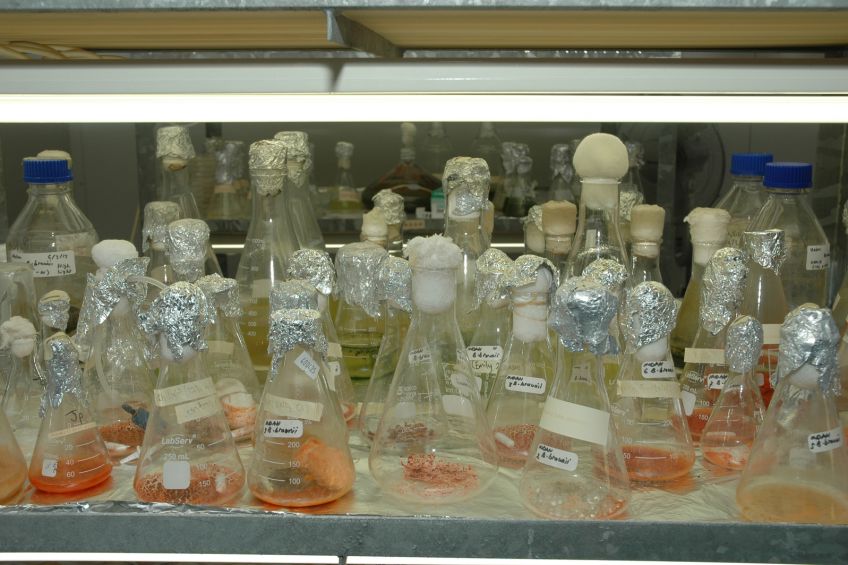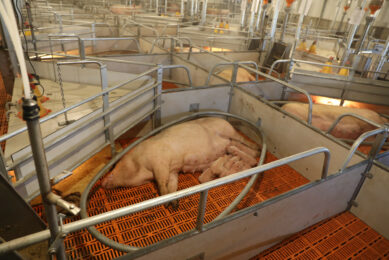Treating piggery waste using microalgae

Novel ways to enable recycling of resources, improve farming efficiency and benefit the environment all motivate research. In the case of wastewater output from pig production, some research might enable benefits in all of these areas.
Wastewater management has long been a focus of attention for pig farmers globally. Among many options available in the treatment of the wastewater, anaerobic digestion provides an excellent first step to handle odour control and reduce organics and much of the hazardous composition of the waste material. However, current technologies struggle to go further to improve the anaerobically generated effluent and provide true potential for recycling of clean water on the scale required for pork production.
Dr Navid Moheimani at the Algae R&D Centre.
Finding the perfect algae strains for pig waste
One potential key technology which might provide the missing link is using microalgae cultivation. Microalgae are photoautotrophic and mixotrophic micro-organisms capable of growth in harsh environments. The hope is that microalgae can enable removal of the remaining pollutants carried in the anaerobically treated wastewater and provide biomass with the potential to be useful in various ways to the pig farmer.
In the several decades of research concerning microalgae treatment of piggery wastewater, this goal has been elusive. The pollutants contained in the wastewater take the form of ammonia, phosphorus and high turbidity levels, which provide toxic conditions for most types of algae and most other living things.
However, there is a new reason to be optimistic regarding this technology as researchers at Murdoch University in Western Australia have isolated several algae strains which appear to grow effectively in piggery anaerobic digestion effluent.
The researchers have been looking for microalgal strains which grow on undiluted wastewater effluent from anaerobic treatment of piggery waste. This effluent is very high in pollutants (i.e. ammonium), which double as potential nutrients for microalgae growth, if microalgae can be found to survive these conditions. Previous research failed to demonstrate successful algae growth unless the anaerobic effluent was heavily diluted (up to 100 times), which puts the technology beyond the practical realities of use in the industry, as water restrictions faced by pig farmers limit the possibilities to dilute the wastewater further.
The approach at Murdoch University’s Algae R&D Centre has been to screen potential microalgal sources using similar conditions to undiluted wastewater properties and trial these in paddle wheel driven raceway ponds, cultivating mixed microalgae cultures in a ‘survival of the fittest’ strategy using actual piggery effluent as the growth media. The results showed that the microalgae can survive and grow effectively and should be capable of growth optimisation and further improvements to overall productivity.
Screening needed to ensure safety in pig feed
Three strains suit the desired conditions, however at this stage they require further trials to identify the most useful output product from the biomass produced. The microalgal biomass might be an excellent nutritional supplement to pig diets, potentially rich in protein, beneficial lipids and other nutrients. This option, however, would require careful screening for possible pathogens and adherence to strict safety measures to demonstrate its safety as a pig feed. Another possible option would be to use the microalgal biomass as a source of organic matter to enhance digestion of anaerobic biogas production. The current approach of treating the wastewater with anaerobic digestion already generates biogas which can potentially be used as a fuel for heating purposes or electricity production and the microalgae biomass might enrich this process and allow capture of more carbon that can be taken up by the algae during photosynthesis.
Both of these biomass products also face an additional challenge of breaking the cell walls to enable digestion by either the pig’s gastro intestinal system if used as a feed, or by the anaerobic methanogen bacterial process if used to generate biogas anaerobically. This should be an achievable step in the process, but requires some further research to demonstrate its full potential.
You may also be interested in:
More efficiency in pig sector needed – Prof Fresco
Players in the agribusiness have to grow both in size, land as well as in productivity in order to be able to deal with the challenges of the future.
Turning wastewater into a valuable resource
Imagine if wastewater, one of the major waste streams from pig production, could be utilised as a valuable resource, rather than merely a nuisance to be dealt with carefully and at considerable expense. Once more data are available on these potential output products, it might become possible to produce a preliminary economic assessment to guide future research and development in this area.
The Cooperative Research Centre for High Integrity Australian Pork (Pork CRC) has invested $300,000 towards this project. The pilot Pork CRC PhD project by Murdoch University student Jeremy Ayre, spanning 2015 through to 2017, will look in-depth at long term cultivation of the microalgae strains, while analysing the limits to growth that might inhibit productivity. It is hoped that by then it is possible to understand the practical measures that can push the growth as far as reasonably possible, while keeping our approach relevant to the context of pig production. High ammonia levels and high turbidity are likely to be significant challenges to long term outdoor cultivation, but the research will tackle these issues head on and investigate likely solutions.
Other pollutants, such as phosphorus and waterborne carbon, can generally benefit algae growth, but also may be toxic at certain concentrations for some algae. The nature of the anaerobic digestate typically changes over time such that nutrient levels might spike or wane at any time, due to piggery management practices and the water volumes used to flush through the farming system. All of these variables impact the microalgae growth conditions. So far, the researchers found the mixed culture to be tough enough to handle the variability but in order to produce sufficient biomass and make the system economically attractive, it must be able to go further and provide a useful end product for the piggery.
Closed photobioreactor systems
Ayre’s project also involves trialling closed photobioreactor systems and comparing these with open raceway ponds, both under outdoor conditions to find the best cultivation system.
The project is also looking at ways to limit ammonia emissions from the growth media and maximise utilisation of the available nitrogen for microalgae growth. Some regions around the globe have strict limitations on gaseous emissions that might harm the environment and the ammonia component is a critical issue in this instance.
The project will attempt cultivation using tightly controlled closed cultivation systems under laboratory conditions and look for ways to limit ammonia losses that can be applied to larger outdoor systems, whether closed photobioreactors or open pond systems. The overall aims of the project touch on many aspects of the wastewater management outcomes.
It might be possible to capture nutrients that would otherwise present an environmental hazard and help reduce ammonia emissions, plus capture greenhouse gases and output cleaner water which might be safe enough to recycle within the piggery or optimise the microalgae cultivation process. The ultimate output from the system will be a biomass product that can be used as a pig feed or as feedstock for the biogas biofuel production process.
| The project is multidisciplinary
This is a multidisciplinary project involving experts with different backgrounds. Dr Moheimani is the project principal investigator, while his Murdoch University colleagues Professor John Pluske, Emeritus Professor Michael Borowitzka and Dr John Huisman are contributing their expertise in nutrient studies, algal cultivation and economics and macroalgal bioprospecting respectively. Dr Sasha Jenkins from the University of Western Australia, is helping to investigate the anaerobic digestion process while Jeremy Ayre is conducting his PhD mainly on microalgae cultivation aspects of the project. He is in his first year of study and his scholarship is co-funded by the Pork CRC and Murdoch University. The project is also supported by the Department of Agriculture and Food Western Australia and University of Melbourne (Dr Peter Cakebread). According to Pork CRC Program Four (‘Carbon Conscious Nutrient Inputs and Outputs’) Leader, Rob Wilson, this exciting area of research for the Pork CRC follows a successful Honours project by Jeremy Ayre. “Australian pork producers are a resourceful group, as demonstrated by the successful uptake of energy replacement by the capture and use of biogas on-farm. This work complements the environmental credentials of pork producers while exploring the possibility of producing a feed source or a co-digestion product for bioenergy output,” Wilson said. |











